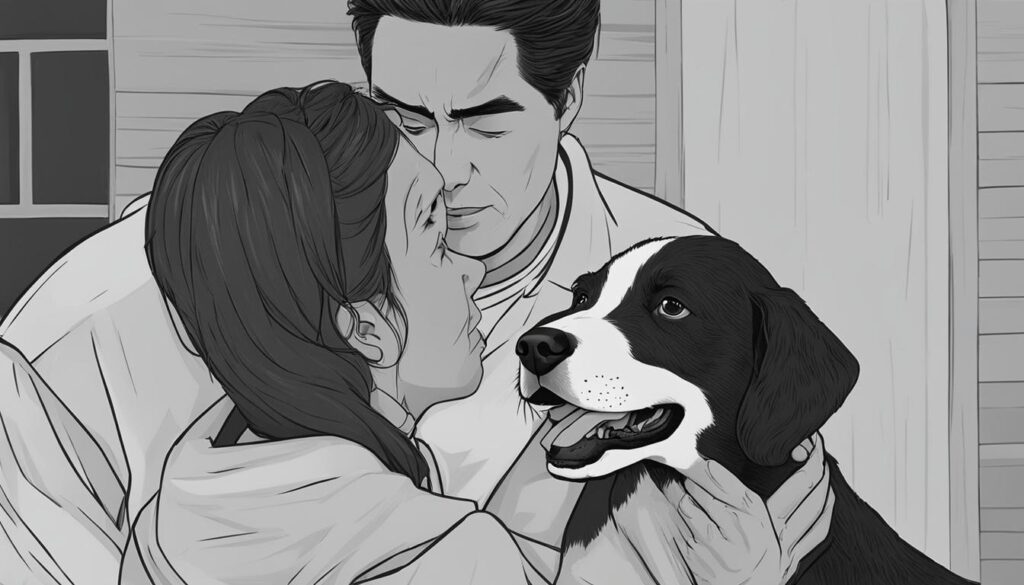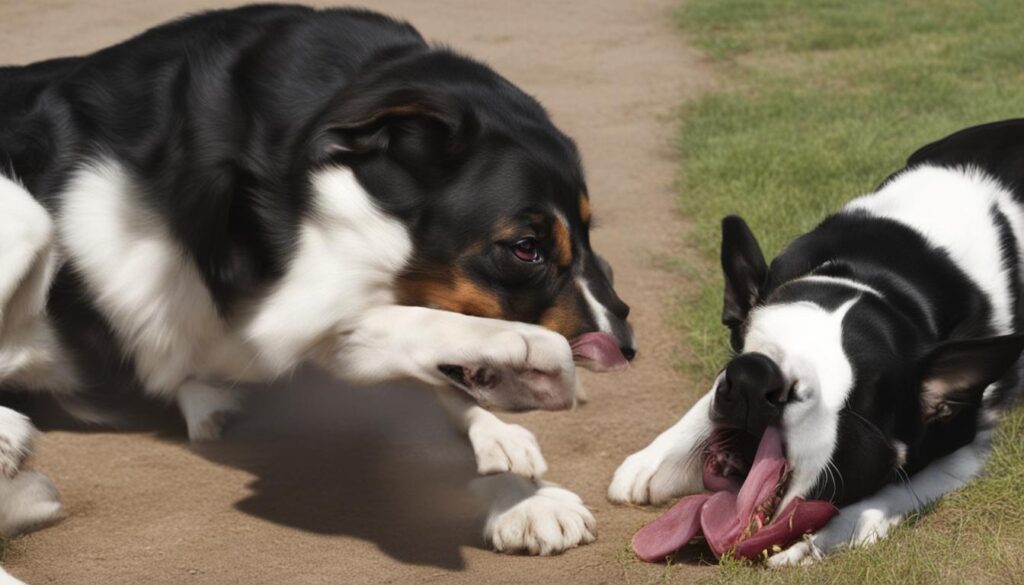As a responsible dog owner, it is crucial to be prepared for emergencies, including instances when your furry friend is choking. Dogs can easily choke on objects, causing obstruction in their airway and putting their lives at risk. Knowing how to respond effectively can make all the difference in saving your pet. In this article, I will provide you with step-by-step guidance and important information on how to handle a choking dog, including remedies, performing the Heimlich maneuver, recognizing signs of choking, administering dog CPR, and implementing emergency actions to clear a dog’s airway.
Key Takeaways:
- Recognize the signs of a choking dog, such as retching, pacing, and pawing at the mouth.
- Take immediate steps by gently restraining your dog and checking for visible objects in the mouth.
- Perform the Heimlich maneuver according to your dog’s size and seek veterinary assistance if necessary.
- Learn dog CPR to restore breathing if your dog becomes unconscious during a choking incident.
- Clear a dog’s airway using proper techniques and seek professional help if unsuccessful.
Signs of Choking in Dogs
Choking in dogs is a critical situation that requires immediate attention. Being able to recognize the signs of choking is crucial in providing prompt assistance to your furry friend. Some common symptoms of a choking dog include:
- Retching
- Pacing back and forth
- Pawing at the mouth
- Inability to make any sound if the airway is completely blocked
It is important to pay close attention to your dog’s behavior and act swiftly if you suspect they are choking. Recognizing these signs can help you intervene effectively and potentially save your dog’s life.
Remember, choking in dogs can be life-threatening, so it’s important to act quickly and seek appropriate help when necessary.
Immediate Steps to Take

When you notice that your dog is choking, it is essential to take immediate action. Every second counts in this life-threatening situation, so follow these steps to provide first aid for your choking dog:
1. Gently Restrain Your Dog
Approach your dog calmly and gently restrain them to protect yourself. However, avoid muzzling them as it can further restrict their breathing and exacerbate the situation.
2. Open Their Mouth and Check for Visible Objects
Carefully open your dog’s mouth and check for any visible objects that can be safely removed. If you can see and reach the object, use tweezers or your fingers to gently extract it from their mouth. Always be cautious not to push the object further into the throat or cause any injury.
3. Use Caution When Performing Any Actions
Exercise extreme caution when attempting to dislodge the object from your dog’s throat. Avoid blind sweeping motions, as this can lead to more harm. If you’re unsure or unable to remove the object within a few minutes, seek immediate veterinary assistance.
It is crucial to act swiftly and calmly when dealing with a choking dog. By following these immediate steps, you can provide your dog with the necessary first aid while ensuring their safety. Remember, if you cannot remove the object or your dog’s condition worsens, do not hesitate to contact your veterinarian for professional help.
Performing the Heimlich Maneuver on a Dog

When a dog is choking and obstructed in their airway, performing the Heimlich maneuver can be a life-saving technique. The steps to perform the Heimlich maneuver on a dog vary depending on their size. Here’s a guide on how to perform the Heimlich maneuver for dogs:
For Smaller Dogs:
- Hold the dog on your lap, ensuring they are facing away from you.
- Gently turn the dog onto their back.
- Place one hand on their back for support and use your other hand to apply firm pressure just below the ribcage.
- Make a quick upward and inward thrust to dislodge the object from the airway.
If the object is not expelled after the first attempt, repeat the process until the dog can breathe normally.
For Medium and Large Dogs:
- Stand behind the dog and wrap your arms around their body.
- Make a fist with one hand and place it just below the ribcage.
- Grab your fist with your other hand.
- Perform upward and inward thrusts, using your bodyweight to create enough force to dislodge the object.
Ensure your movements are confident and controlled while performing the Heimlich maneuver on your dog. Take care not to apply excessive force that could cause harm.
Remember, it is crucial to seek immediate veterinary assistance after performing the Heimlich maneuver on your dog, even if the object is successfully removed. A professional evaluation will ensure there are no underlying issues or injuries.
Dog CPR for Choking Emergencies

In some cases, a choking dog may become unconscious and stop breathing. In such situations, performing dog CPR can help to restore their breathing. It involves a combination of chest compressions and rescue breaths. The recommended ratio is 30 chest compressions to 2 breaths. It is crucial to ensure proper positioning and technique when performing CPR on a dog.
When administering dog CPR, it’s important to follow these steps:
- Place your dog on a firm surface, preferably on their right side if possible.
- Locate the heart area, which is just behind the left elbow.
- Perform chest compressions by placing one hand on top of the other and using the heel of your palm to press down firmly. For smaller dogs, you can use just one hand.
- Compress the chest at a rate of approximately 100-120 compressions per minute.
- After every 30 chest compressions, give your dog two rescue breaths.
- To give rescue breaths, close your dog’s mouth and form a seal over their muzzle. Breathe into their nose until you see the chest rise.
- Continue with the cycle of 30 compressions and 2 breaths until your dog starts breathing on their own or until you reach a veterinary clinic.
Performing CPR on a choking dog can be physically demanding and emotionally stressful. It is important to remain as calm as possible while providing emergency care for your dog. Remember, time is of the essence, and seeking veterinary assistance is crucial even if you are successful in restoring your dog’s breathing temporarily.
Clearing a Dog’s Airway

Clearing a dog’s airway involves various techniques depending on the situation. When a dog is choking, it is crucial to act quickly and effectively to remove the obstruction and restore their breathing. Here are the steps to clear a dog’s airway:
- 1. Assess the situation: Determine if the object causing the choking is visible and within reach. If it is not visible or you are unable to remove it safely, seek immediate veterinary assistance.
- 2. Remove visible objects: If you can see the object in the dog’s mouth, attempt to remove it using your fingers or a pair of long, curved tweezers. Be careful not to push the object further into the throat or cause any injury.
- 3. Apply firm pressure under the jaw: If the object is larger and cannot be easily removed, apply firm pressure with both hands under the jaw at the base of the throat. This may help dislodge the object and allow it to be coughed up.
- 4. Perform abdominal thrusts: In some cases, the Heimlich maneuver can be used to clear a dog’s airway. This technique involves standing behind the dog, placing your hands just below the rib cage, and applying firm upward pressure to the abdomen. However, it is essential to use caution and only perform this maneuver if you are confident and trained to do so.
If these methods are unsuccessful or you are unsure about what to do, it is crucial to seek immediate veterinary assistance. A professional can provide the necessary expertise and equipment to clear the dog’s airway safely.
Note: Always consult with a veterinarian for proper guidance and training on dog choking first aid.
Aftermath and Follow-Up Care

After a choking incident, it is crucial to prioritize your dog’s well-being by seeking immediate veterinary care. A thorough examination by a veterinarian is essential to assess for any internal damage or lingering discomfort that may have resulted from the choking episode. It is important to follow their guidance and recommendations for follow-up care to ensure your dog’s full recovery.
The veterinarian may suggest various treatments based on your dog’s specific condition. These may include pain relief medication to alleviate any discomfort your dog may be experiencing. Additionally, a soft food diet may be recommended to ease swallowing and reduce the risk of further irritation to the throat. In some cases, further diagnostic procedures, such as X-rays or endoscopy, may be necessary to rule out any underlying issues or evaluate the state of the airway.
Monitoring your dog’s recovery closely is crucial during this time. Observe their eating habits, breathing patterns, and overall behavior. If you notice any signs of discomfort, difficulty swallowing, or respiratory distress, contact your veterinarian immediately for further guidance.
Common Follow-Up Care Recommendations for Dogs After a Choking Incident
| Follow-Up Care Recommendations |
|---|
| Thorough examination by a veterinarian |
| Pain relief medication, if necessary |
| Soft food diet |
| Possible diagnostic procedures (X-rays, endoscopy, etc.) |
| Closely monitor eating habits, breathing, and behavior |
| Contact veterinarian if signs of discomfort or respiratory distress are observed |
Preventing Future Choking Incidents

Taking preventive measures can greatly reduce the risk of future choking incidents. Here are some essential tips to keep your dog safe:
- Closely monitor your dog during playtime to prevent them from swallowing objects that could potentially cause choking.
- Avoid giving your dog small toys, bones, or any objects that can easily become lodged in their throat.
- Provide appropriate toys that are durable and safe for chewing, such as chew ropes or Kong toys.
- Keep dangerous substances and small items out of your dog’s reach. This includes household chemicals, medications, sharp objects, and small children’s toys.
By implementing these simple precautions, you can significantly reduce the chances of your dog choking and ensure their safety.
Quote:
“Prevention is key when it comes to dog choking incidents. Being vigilant and proactive can save your dog from a potentially life-threatening situation.” – Dr. Emily Cooper, Veterinarian
Importance of Dog First Aid Training
As a responsible dog owner, it is crucial to prioritize the safety and well-being of your furry companion. One way to ensure you are prepared for any emergency is by investing in dog first aid training. Learning dog first aid, including techniques for handling choking situations, can provide you with the knowledge and skills necessary to act swiftly and effectively in critical situations.
By enrolling in dog first aid courses, you gain hands-on training and valuable insights into administering immediate care to a choking dog, as well as other essential skills. These courses cover a range of topics such as pet emergency preparedness, recognizing signs of distress, performing life-saving techniques, and implementing proper first aid measures.
One of the significant benefits of dog first aid training is the confidence it instills in you, knowing that you have the ability to act decisively in an emergency. This confidence stems from the knowledge you acquire during the training, empowering you to make informed decisions and administer appropriate care when every second counts.
Besides addressing choking incidents, dog first aid courses also equip you with the necessary skills to handle other emergencies such as injuries, poisoning, heatstroke, and more. This comprehensive training ensures that you are well-prepared to respond effectively to a wide range of potential threats to your dog’s health and safety.
Furthermore, dog first aid training provides an opportunity for you to connect with like-minded individuals who share a passion for the well-being of their pets. This sense of community fosters an environment where you can exchange knowledge, ask questions, and learn from others’ experiences.
To summarize, investing in dog first aid training is a proactive step in safeguarding your dog’s health and well-being. By learning the necessary skills and protocols, you can confidently respond to choking emergencies and other critical situations that may arise. The knowledge gained from these courses empowers you to take immediate action, potentially saving your beloved pet’s life.
| Benefits | Description |
|---|---|
| Increased Confidence | Gain the confidence to handle critical situations effectively. |
| Comprehensive Training | Learn various first aid techniques for different emergencies. |
| Community Engagement | Connect with other dog owners passionate about pet safety. |
| Potential Lifesaving Skills | Acquire the knowledge to save your dog’s life in emergencies. |
Wrapping Up
Choking is a serious emergency in dogs, and quick action is crucial to save your pet’s life. By recognizing the signs of choking, knowing how to perform the Heimlich maneuver, administering dog CPR, and seeking veterinary care, you can effectively respond to a choking incident. Prioritizing the well-being of your dog and seeking professional help when needed is essential.
Remember, prevention is key to avoid future choking incidents. Close supervision during playtime, providing safe chew toys, and keeping hazardous objects out of reach can greatly reduce the risk. Additionally, learning dog first aid, including choking situations, through proper training equips you with the knowledge and confidence to handle critical moments.
In summary, being prepared, staying calm, and taking immediate action are crucial when dealing with a choking dog. With the right knowledge and steps, you can be a capable caregiver and potentially save your beloved pet’s life. Prioritize their safety and well-being, and always consult a veterinarian for any concerns or follow-up care.
FAQ
What are the signs of choking in dogs?
The signs of choking in dogs include retching, pacing back and forth, pawing at the mouth, and being unable to make any sound if the airway is completely blocked.
What immediate steps should I take when my dog is choking?
When your dog is choking, gently restrain them, open their mouth, and check for any visible objects that can be safely removed. If you cannot dislodge the object within a few minutes, seek veterinary assistance.
How do I perform the Heimlich maneuver on a dog?
For smaller dogs, hold them on your lap, turn them onto their back, and apply firm pressure just below the rib cage. For medium and large dogs, wrap your arms around them, make a fist, and perform upward and inward thrusts.
How do I perform CPR on a choking dog?
Performing dog CPR involves a combination of chest compressions and rescue breaths. The recommended ratio is 30 chest compressions to 2 breaths.
How can I clear a dog’s airway in a choking emergency?
Clearing a dog’s airway involves attempting to remove visible objects using fingers or tools, and applying firm pressure under the jaw at the base of the throat to dislodge larger objects. If these methods are unsuccessful, seek immediate veterinary assistance.
What should I do after a dog choking incident?
After a choking incident, have your dog thoroughly examined by a veterinarian. The vet may recommend treatments such as pain relief, a soft food diet, or further diagnostic procedures.
How can I prevent future choking incidents in my dog?
To prevent future choking incidents, closely monitor your dog during playtime, avoid giving them objects that can easily become lodged in their throat, and keep dangerous substances and small items out of their reach.
Why is dog first aid training important?
Dog first aid training is important because it equips dog owners with the knowledge and skills to administer immediate care in emergencies, including choking situations. It increases confidence and preparedness for any emergency.
Can knowing dog first aid potentially save my pet’s life?
Yes, knowing dog first aid can potentially save your pet’s life. By knowing the signs of choking, performing the Heimlich maneuver, administering dog CPR, and seeking veterinary care, you can effectively respond to a choking situation.






